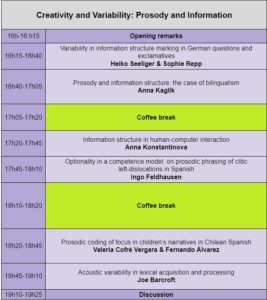Creativity and Variability: Prosody and Information
Organizers
Jutta Hartmann (University of Bielefeld, Germany)
Farhat Jabeen (University of Bielefeld, Germany)
Petra Wagner (University of Bielefeld, Germany)
Summary description
Creativity is one of the defining features of human interaction. Linguistic creativity may manifest itself in terms of innovative novel forms and/or in the suppression and eventual abandonment of existing structure in a language. In this respect, phonetic and prosodic variation might be considered linguistic creativity. It also shows the production of novel forms that are either discarded or subsumed into a general analysis based on the most frequent forms. Such variation has also been found in the prosodic marking of information-structure making it especially difficult to determine the deviant vs. convention status of a form. Such phonetic and prosodic variability may result from a number of factors including but not limited to speaker, context as well as linguistic and dialectal structures. Yet, there are few existing attempts aiming to model this variation. Empirical studies generally do not clarify the processing of a novel and ‘deviant’ form in contrast to a ‘canonical’ or ‘non-deviant’ form in their data.
In this workshop, we aim to look at phonetic and prosodic variability as potential linguistic creativity. We are interested in investigating variable phonetic and prosodic realizations in different information-structural contexts with a special focus on the creative aspects of such use and interpretation of variable forms. The overall aim is to develop a better understanding of phonetic and prosodic variability caused by the above mentioned (and hitherto undiscussed) factors and how it manifests itself in the context of variable IS.
Topics and areas of interest
The areas of interest for this workshop pertain to the following research questions:
- What are the factors resulting in systematic phonetic variability in the encoding of IS?
- How do dialogue partners ‘handle’ variability in production and/or perception of linguistic forms in a given IS notion? To what extent can this handling be called creative?
- What is a ‘deviant’ form? How is its deviance determined and integrated in an analysis?
- How can we model variability, including grammatical, prosodic, computational and statistical approaches to modeling variation? Comparisons and critiques of existing models and proposals for new ones are highly welcome.
- How to model the interface between phonetic and prosodic variability and IS? How does a given model fit with the current approaches to IS and phonetic and prosodic variability?
Organization details
It will be a two-hours (16:00-19:00 CET) workshop comprising talks of 15-minutes (plus 5 minutes for Q/A). This is a tentative schedule subject to change on the basis of the number of submissions and accepted abstracts. The workshop is intended to offer only oral presentations.
Program
